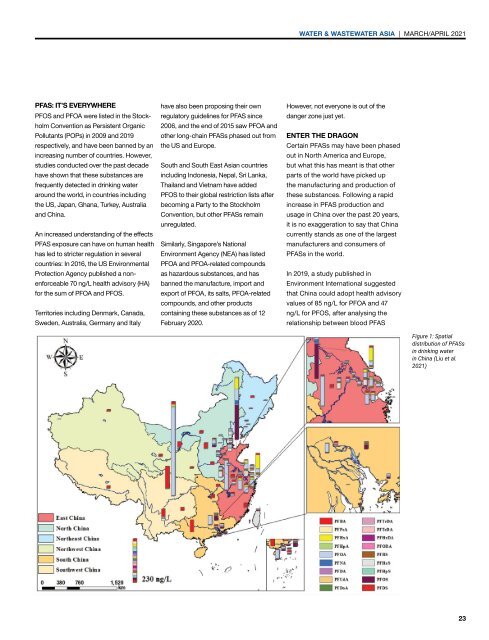Water & Wastewater Asia March/April 2021
Water & Wastewater Asia is an expert source of industry information, cementing its position as an indispensable tool for trade professionals in the water and wastewater industry. As the most reliable publication in the region, industry experts turn this premium journal for credible journalism and exclusive insight provided by fellow industry professionals. Water & Wastewater Asia incorporates the official newsletter of the Singapore Water Association (SWA).
Water & Wastewater Asia is an expert source of industry information, cementing its position as an indispensable tool for trade professionals in the water and wastewater industry. As the most reliable publication in the region, industry experts turn this premium journal for credible journalism and exclusive insight provided by fellow industry professionals. Water & Wastewater Asia incorporates the official newsletter of the Singapore Water Association (SWA).
You also want an ePaper? Increase the reach of your titles
YUMPU automatically turns print PDFs into web optimized ePapers that Google loves.
WATER & WASTEWATER ASIA | MARCH/APRIL <strong>2021</strong><br />
PFAS: IT’S EVERYWHERE<br />
PFOS and PFOA were listed in the Stockholm<br />
Convention as Persistent Organic<br />
Pollutants (POPs) in 2009 and 2019<br />
respectively, and have been banned by an<br />
increasing number of countries. However,<br />
studies conducted over the past decade<br />
have shown that these substances are<br />
frequently detected in drinking water<br />
around the world, in countries including<br />
the US, Japan, Ghana, Turkey, Australia<br />
and China.<br />
An increased understanding of the effects<br />
PFAS exposure can have on human health<br />
has led to stricter regulation in several<br />
countries: In 2016, the US Environmental<br />
Protection Agency published a nonenforceable<br />
70 ng/L health advisory (HA)<br />
for the sum of PFOA and PFOS.<br />
Territories including Denmark, Canada,<br />
Sweden, Australia, Germany and Italy<br />
have also been proposing their own<br />
regulatory guidelines for PFAS since<br />
2006, and the end of 2015 saw PFOA and<br />
other long-chain PFASs phased out from<br />
the US and Europe.<br />
South and South East <strong>Asia</strong>n countries<br />
including Indonesia, Nepal, Sri Lanka,<br />
Thailand and Vietnam have added<br />
PFOS to their global restriction lists after<br />
becoming a Party to the Stockholm<br />
Convention, but other PFASs remain<br />
unregulated.<br />
Similarly, Singapore’s National<br />
Environment Agency (NEA) has listed<br />
PFOA and PFOA-related compounds<br />
as hazardous substances, and has<br />
banned the manufacture, import and<br />
export of PFOA, its salts, PFOA-related<br />
compounds, and other products<br />
containing these substances as of 12<br />
February 2020.<br />
However, not everyone is out of the<br />
danger zone just yet.<br />
ENTER THE DRAGON<br />
Certain PFASs may have been phased<br />
out in North America and Europe,<br />
but what this has meant is that other<br />
parts of the world have picked up<br />
the manufacturing and production of<br />
these substances. Following a rapid<br />
increase in PFAS production and<br />
usage in China over the past 20 years,<br />
it is no exaggeration to say that China<br />
currently stands as one of the largest<br />
manufacturers and consumers of<br />
PFASs in the world.<br />
In 2019, a study published in<br />
Environment International suggested<br />
that China could adopt health advisory<br />
values of 85 ng/L for PFOA and 47<br />
ng/L for PFOS, after analysing the<br />
relationship between blood PFAS<br />
Figure 1: Spatial<br />
distribution of PFASs<br />
in drinking water<br />
in China (Liu et al.<br />
<strong>2021</strong>)<br />
23


















